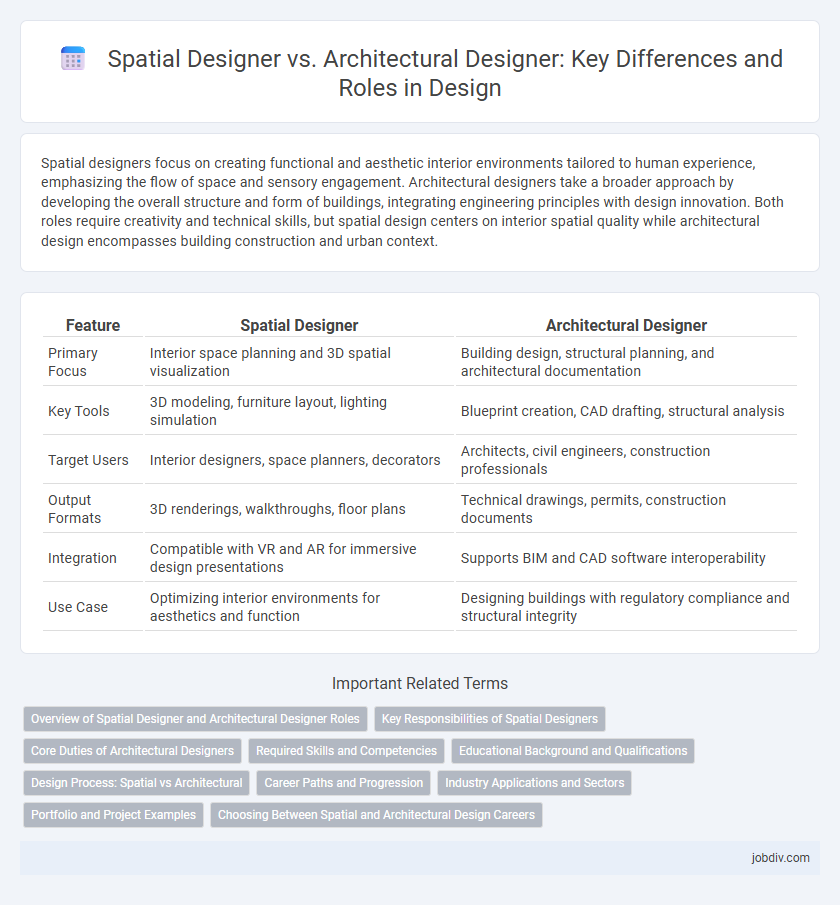Spatial designers focus on creating functional and aesthetic interior environments tailored to human experience, emphasizing the flow of space and sensory engagement. Architectural designers take a broader approach by developing the overall structure and form of buildings, integrating engineering principles with design innovation. Both roles require creativity and technical skills, but spatial design centers on interior spatial quality while architectural design encompasses building construction and urban context.
Table of Comparison
| Feature | Spatial Designer | Architectural Designer |
|---|---|---|
| Primary Focus | Interior space planning and 3D spatial visualization | Building design, structural planning, and architectural documentation |
| Key Tools | 3D modeling, furniture layout, lighting simulation | Blueprint creation, CAD drafting, structural analysis |
| Target Users | Interior designers, space planners, decorators | Architects, civil engineers, construction professionals |
| Output Formats | 3D renderings, walkthroughs, floor plans | Technical drawings, permits, construction documents |
| Integration | Compatible with VR and AR for immersive design presentations | Supports BIM and CAD software interoperability |
| Use Case | Optimizing interior environments for aesthetics and function | Designing buildings with regulatory compliance and structural integrity |
Overview of Spatial Designer and Architectural Designer Roles
Spatial Designers specialize in creating functional and aesthetically pleasing three-dimensional environments, integrating elements such as lighting, materials, and furniture to enhance user experience. Architectural Designers focus on the structural design and planning of buildings, ensuring compliance with safety regulations, building codes, and sustainability standards. Both roles require collaboration with clients and contractors, but Spatial Designers emphasize interior and experiential aspects, while Architectural Designers prioritize construction feasibility and structural integrity.
Key Responsibilities of Spatial Designers
Spatial Designers specialize in creating functional and aesthetically pleasing interior environments by strategically organizing space, focusing on human interaction, flow, and sensory experience. They develop detailed layouts, select materials, lighting, and furnishings that enhance spatial usability and ambiance, often collaborating closely with architects and clients. Their work bridges interior design and architecture, emphasizing spatial planning that optimizes both practical use and emotional impact.
Core Duties of Architectural Designers
Architectural designers primarily focus on planning and creating building designs that ensure structural integrity, functionality, and compliance with building codes and regulations. Their core duties include developing detailed blueprints, coordinating with engineers and contractors, and overseeing project timelines to meet client specifications. They integrate aesthetic considerations with practical requirements to deliver safe, sustainable, and innovative architectural solutions.
Required Skills and Competencies
Spatial Designers must excel in spatial awareness, 3D visualization, and user experience design, with strong skills in software like AutoCAD, SketchUp, and Adobe Creative Suite. Architectural Designers require in-depth knowledge of building regulations, construction methods, structural engineering principles, and proficiency in BIM tools such as Revit. Both roles demand creativity, technical drawing abilities, and strong communication skills to collaborate effectively with clients and contractors.
Educational Background and Qualifications
Spatial designers typically hold degrees in spatial or interior design, focusing on the arrangement and functionality of indoor environments, emphasizing creativity and user experience. Architectural designers often have formal education in architecture, requiring more rigorous training in structural principles, building codes, and technical drafting, which may lead to licensure as professional architects. Both roles demand strong design skills, but architectural designers usually undergo extensive qualifications, including accredited programs and licensing exams, to ensure compliance with safety and regulatory standards.
Design Process: Spatial vs Architectural
Spatial Designers prioritize user experience by organizing environments through spatial flow, lighting, and materials to enhance functionality and emotional impact. Architectural Designers emphasize structural integrity, compliance with building codes, and the integration of mechanical systems within the design process. Both disciplines require collaboration but differ as Spatial Designers focus on interior spatial relationships while Architectural Designers oversee the broader construction framework.
Career Paths and Progression
Spatial Designers focus on creating functional and aesthetic environments inside buildings, incorporating elements like lighting, furniture, and spatial flow, while Architectural Designers primarily develop building structures and exterior forms. Career progression for Spatial Designers often leads to roles in interior design, exhibition design, or urban planning, whereas Architectural Designers typically advance towards licensed architect positions, project management, or urban design consultancy. Both career paths demand strong technical skills, creativity, and an understanding of building regulations, but Architectural Designers require formal architectural qualifications for higher-level certifications.
Industry Applications and Sectors
Spatial designers specialize in creating functional and aesthetic interior environments, often working within sectors like retail, hospitality, and exhibition design where user experience and spatial flow are critical. Architectural designers focus on building design and construction, engaging primarily with residential, commercial, and institutional projects that require structural planning, zoning compliance, and sustainability considerations. Both roles overlap in sectors such as urban planning and public infrastructure, but spatial designers prioritize interior spatial arrangement while architectural designers address macro-scale building integrity and environmental impact.
Portfolio and Project Examples
Spatial Designers prioritize fluid and immersive experiences using 3D modeling and environmental storytelling, showcasing portfolios rich with interactive installations and adaptive interior spaces. Architectural Designers emphasize structural integrity and regulatory compliance, presenting project examples like commercial buildings, residential complexes, and urban development plans that highlight technical precision and sustainability. Effective portfolios integrate visualizations, technical drawings, and client briefs to demonstrate design intent and multidisciplinary collaboration.
Choosing Between Spatial and Architectural Design Careers
Choosing between a Spatial Designer and an Architectural Designer career depends on your interest in interior and experiential spaces versus building structures and urban environments. Spatial Designers typically specialize in optimizing interior layouts, exhibition spaces, and retail environments with a focus on user experience and functionality. Architectural Designers focus on designing buildings, structural integrity, and urban planning, requiring knowledge of engineering, building codes, and environmental impact.
Spatial Designer vs Architectural Designer Infographic

 jobdiv.com
jobdiv.com